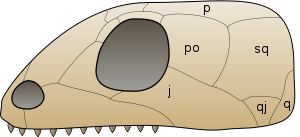Quadrate bone

The quadrate bone is part of a skull in most tetrapods, including amphibians, sauropsids (reptiles, birds), and early synapsids. In these animals it connects to the quadratojugal and squamosal in the skull, and forms part of the jaw joint (the other part is the articular bone at the rear end of the lower jaw).
It is formed by endochondral ossification and is formed from the hindmost part of the primitive cartilaginous upper jaw.
Evolutionary variation
In snakes, the quadrate bone has become elongated and very mobile, and contributes greatly to their ability to swallow very large prey items. In some lizards and dinosaurs also the quadrate is articulated at both ends and movable.
In mammals the articular and quadrate bones have migrated to the middle ear and are known as the malleus and incus. This migration was first described by Reichert in 1837. In pig embryos he discovered that the mandible ossifies on the side of Meckel's cartilage, while the posterior part of that cartilage is ossified and then detaches from the rest of the cartilage to enter the middle ear where it becomes the incus.[1]
See also
Notes
- ↑ Scott 2000, Paragraph starting with "The original jaw bones changed also. [...] "
References
- Gilbert, Scott F. (c. 2000). "The anatomical tradition: Evolutionary Embryology: Embryonic homologies". Developmental Biology. Sunderland (MA): Sinauer Associates, Inc. (NCBI). Retrieved January 2010.
External links
- Bioweb at UWLAX Image
- "Dorsal View Snapping Turtle Skull (Photo)". Murray State University. Retrieved January 2010.